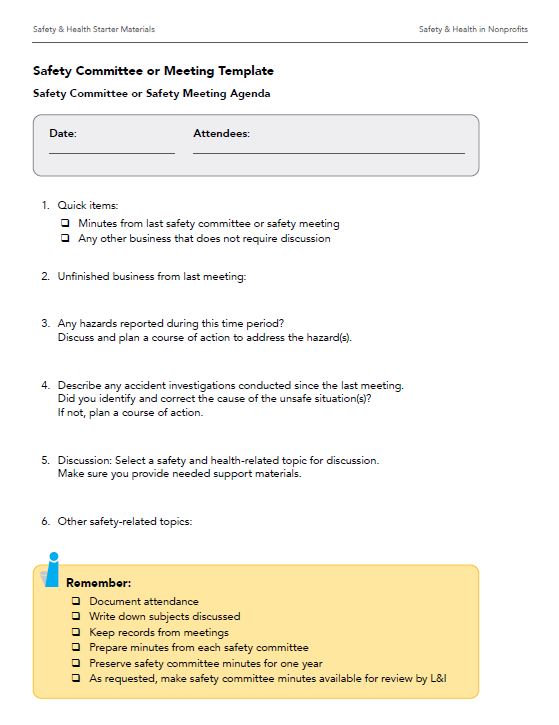Sustaining a strong safety and health culture takes more than laying out a solid program or plan for your organization. When and where does important safety and health work happen? L&I requires employers to have either a safety committee or safety meeting that creates space for leadership and employees to identify hazards, address concerns, and evaluate program effectiveness.
Topics covered:
What is required?
All employers are required to have either a safety committee or safety meeting, whichever is most appropriate for the organization based on specific criteria (WAC 296-800-130) that is outlined in the table below.
There are clear differences between a safety committee and a safety meeting.
Safety Committee (WAC 296-800-13020):
- Organizational structure where members represent a group – giving everyone a voice while keeping the meeting size to an effective number of participants
- Has employee-elected and employer-selected members
- Has an elected chairperson
- Determines how often, when, and where the safety committee will meet
- Must prepare minutes for each safety committee meeting, preserve the record for one-year, and make available for review by L&I safety and health consultation personnel
Safety Meeting (WAC 296-800-13025):
- Includes all employees and at least one management representative to ensure issues are addressed
- Required to happen at least monthly
- No formal documentation requirement, except for writing down who attended and the topics discussed
Who should serve?
If your organization conducts safety meetings, be sure all employees are included and at least one management representative is present.
If your nonprofit has a safety committee, make sure the committee has employee-elected and employer-selected members; the number of employee-elected members must equal or exceed the number of employer-selected members. If you are creating a new safety committee, review WAC 296-800-13020 for guidelines on committee make up, required topics to cover, and documentation needs.
What to talk about?
A little planning can really help create productive meeting spaces. A safety committee and safety meetings should also guide a feedback process that strengthens practices. Review the following general and organization-specific topics as you create agendas for your organization’s safety meetings (or safety committee meetings). Your nonprofit’s insurance carrier may also have resources and recommended topics. A sample safety meeting agenda is provided below. L&I also offers a Safety Committee and Meetings resource document, which includes an optional safety meeting notes/minutes template.
General Topics:
- What to do in case of a specific emergency (for example, fire, earthquake, or chemical spill)
- Using a mobile phone while driving
- Proper lifting techniques
- Using the emergency eyewash
- Recognizing the effects of carbon monoxide
- Problems using ladders
- Loading dock safety
- Stretching exercises to prevent injuries
- How to keep the walkways clear and reduce clutter
- Seasonal hazards (for example, rain, cold, heat, wildfire smoke, or darkness)
- Leaving work after dark
- How to predict an accident
- Watching out for “road rage”
- Using a fire extinguisher
- First aid-personnel training and supplies
Organization Specific Topics:
- Current personal protective equipment inventory (Is the inventory adequate and up-to-date?)
- How to safely operate a new piece of equipment the organization has acquired
- How to report unsafe conditions and near misses
- How someone in a similar organization got injured
- A “close call” that someone reported (for example, a near miss by a forklift
- Map possible causes of injury and potential unsafe situations in the workplace
- Review safety and health inspection reports to help correct hazards
- Evaluate accident investigations conducted since the last meeting to determine if the cause(s) of the unsafe situation was identified and corrected
- Evaluate your workplace Accident Prevention Program and discuss recommendations for improvements, if needed
- Discuss what would make safety committee and safety meetings more effective

Tool: Safety Committee or Meeting Template
Use the Safety Committee or Meeting Template as a starting place for your meetings.

Safety Meeting or Committee Agenda Template
Use this template for your safety meetings or committee, or adjust it to your organization's needs.
Download